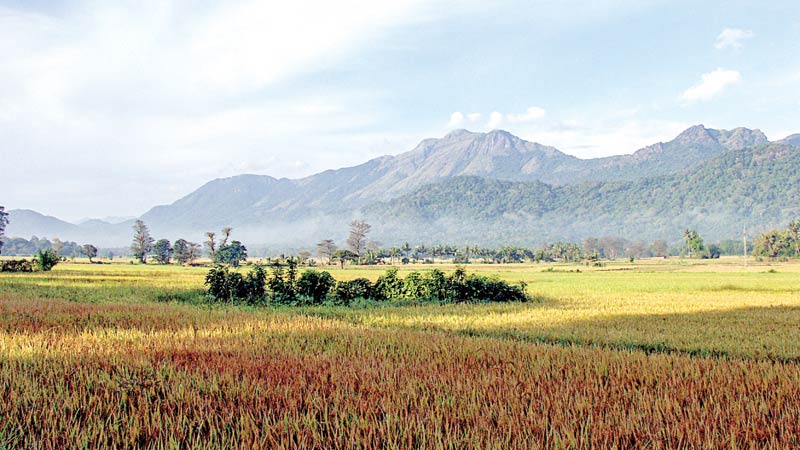 As a 20 year-old boy, I visited Mahiyanganaya for the first time four decades ago with my mother on a pilgrimage. I had a camera and was fascinated by the Adivasi Aththo (Veddhas), especially, the elders with long white cotton beards who flocked to Mahiyangana Temple to entertain the pilgrims, performing ritual and reciting stanzas.
As a 20 year-old boy, I visited Mahiyanganaya for the first time four decades ago with my mother on a pilgrimage. I had a camera and was fascinated by the Adivasi Aththo (Veddhas), especially, the elders with long white cotton beards who flocked to Mahiyangana Temple to entertain the pilgrims, performing ritual and reciting stanzas.
Although the picture was lost today, I still remember the shot I captured of an elderly Veddah with a long beard performing his ritual moving his small axe and singing their customary melodious song.
Recently, we visited Mahiyanganaya again with my family. We left Ratnapura early in the morning along the Bandarawela-Badulla- Migahakivla (B36) highway. Before reaching Mahiyanganaya, we spotted the placid reservoir, the Loggal Oya displaying its charming beauty. It was a smooth drive now unlike it was 40 years ago. A new, wider carpeted road has been built and is used by travellers.
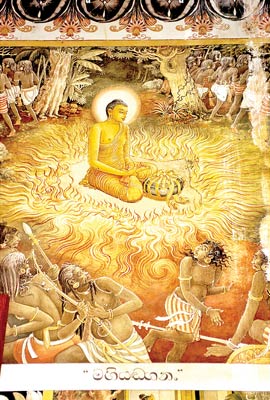
The wall painting at the Kelaniya Vihara shows the Buddha’s visit to Mahiyanganaya on the Duruthu full Moon Poya Day to settle a dispute between the Yakkas and Nagas (two tribes which inhabited the area)
Mahiyangana is a Pali word (in Sinhala: Bintenna) which means flat land. It is situated Eastwards to the steep Eastern falls of the central hills. The relative flatness of the area can be seen while travelling on the road from Kandy to Padiyathalawa across Hunnasgiriya and famous 18 hairpin bends.
Mahiyangana is among the most important places of veneration for the Buddhists. Its significance is illustrated by the fact that Mahiyangana is placed in the number one position among the 16 places believed to have been hallowed by the visits of the Buddha. ‘Mahiyanganam Nagadeepam Kalyanam Padlanchanam…’ is how the stanza worshipping the ‘Solosmasthana’ – the 16 places of veneration – begins, referring to Mahiyangana, Nagadeepa, Kelaniya and Sri Pada. This really is the order in which the Buddha visited these places. Being the first place visited by the Buddha, Mahiyangana occupies pride of place.
Delightful garden
The Mahavamsa – Great Chronicle – records the first visit of the Buddha nine months after Enlightenment on the ‘Duruthu’ (January) Full Moon Day, “In the midst of Lanka, on the fair river bank, in the delightful garden three yojanas long and a yojana wide there was a great gathering of the yakkhas dwelling in the island. To this great gathering of the yakkhas went the Blessed One, and there, in the midst of that assembly, hovering in the air over their heads, he struck terror to their hearts by rain, storm, darkness and so forth. The Yakkhas, overwhelmed by fear, besought the fearless Vanquisher to release them from terrors.”
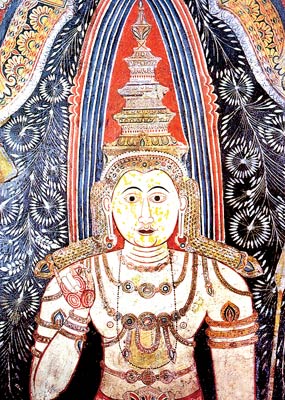
God Saman as depicted at the
Kelaniya Vihara
The Buddha dispelled their fears, got them to make way for him to come down, spread a rug and seated on it preached to them. He advised them to shift to Giripada, possibly in the interior highlands. Among the deities (devas) who gathered to listen to the Buddha was Sumana (Saman deviyo), whose abode was the mountain Samanthakuta.
First stupa
He pleaded with the Buddha to leave something to worship. The Buddha “passing his hand over his head bestowed on him a handful of hairs” which deity Sumana placed in a golden urn and built a stupa over it at the very spot where the Buddha sat. Thus, the first stupa to be built in Sri Lanka was at Mahiyangana on the banks of the Mahaweli Ganga, the country’s longest river.
Over several centuries, Sinhalese kings continued to enlarge the stupa. After the passing-away of the Buddha, the collar-bone of the Buddha was picked up from the ashes and brought by a bhikkhu, Arhant Sarabhu, to Mahiyangana.
He placed the relic in the stupa and built over it. It has been recorded that King Devanampiyatissa’s brother had covered the dagaba over and made it 30 cubits high for greater security. King Dutugemunu (161-137 BC) dwelt in Mahiyangana during his march to Anuradhapura to capture the kingdom invaded by the Tamils. He enlarged the dagaba to 80 cubits high. It was subsequently rebuilt by King Vijayabahau (1055-1110 CE), who ruled from Polonnaruwa.
The Mahiyangana temple was mentioned in commercial transactions in the time of the ancient kings. The Badulla inscription of King Udaya IV (946-954 CE) has a reference to commercial activity in the area.
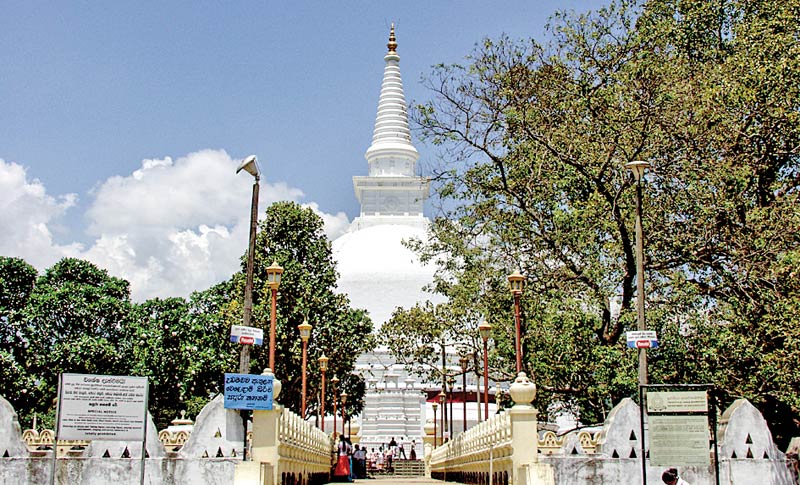
The Mahiyangana dagaba
According to regulations stipulated in the inscription, a trader who kept his shop open on a Poya day was liable to supply a certain quantity of oil for the burning of lamps at the temple. If he failed to do so, a fine was imposed and the collection was used for the same purpose.
There is also reference in the inscription to the fact that the king used to visit the temple.
Over the years, Mahiyangana, like most other places was covered by jungle with movements in the population. It was in the early 1940s that the need to restore Mahiyangana was seriously looked at. D. S. Senanayake, who was the then Minister of Agriculture and Lands in the State Council, took the initiative in forming the Mahiyangana Restoration Committee heading it himself.
Restoration work continued for over a decade. Today, Mahiyangana has become a popular place of Buddhist worship with devotees making it a regular spot in their pilgrimages.
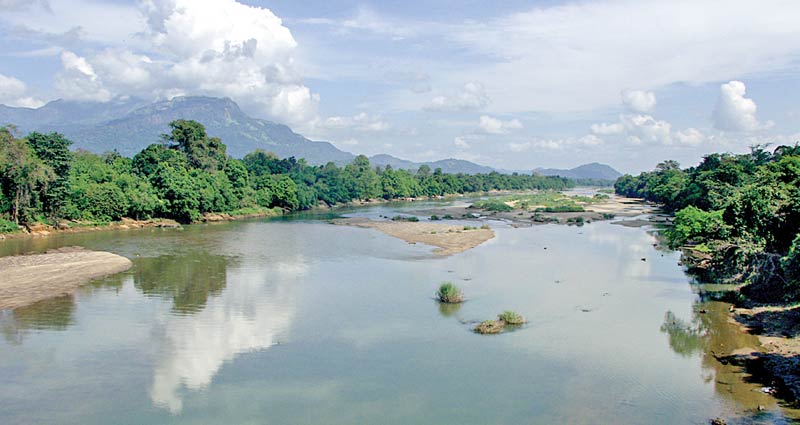
The Mahaweli Ganga which flows near the Mahiyangana temple






